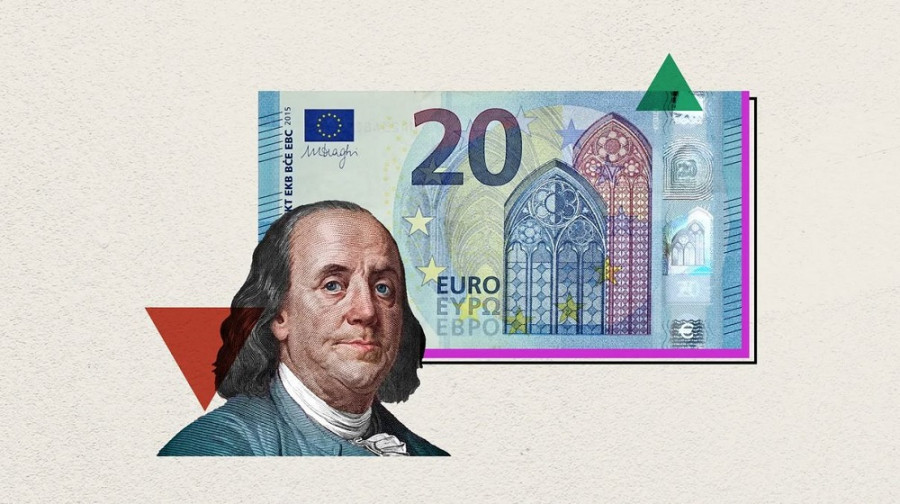The upcoming trading week promises to be volatile across all dollar pairs, and the EUR/USD pair will be no exception. The tone of trading will be set by the United States, where key macroeconomic reports on GDP growth, inflation, and retail sales will be published.
By the end of the week, "dovish" expectations regarding the Federal Reserve's future actions will either be strengthened or weakened. The American currency will respond accordingly, determining the configuration of major currency pairs.
Monday
The economic calendar on Monday is practically empty. The only point of interest might be the German IFO indices. Specifically, the business climate indicator for Germany is expected to rise slightly to 88.6. The indicator showed positive dynamics for eight months (from January to August), reaching 88.9, but unexpectedly fell to 87.7 in September. In October, the index recovered to 88.4, and further growth is expected in November. Even a slight increase in the indicator could support the euro, as the dynamics themselves are important here – positive dynamics.
The IFO economic expectations indicator is also expected to rise, increasing to 92.6. However, the current situation indicator may fall again—this time to 84.5. The downward trend has been recorded for three months, and November could mark the fourth month in this series. If the indicators come in at forecast levels, it will indicate that German businesses are cautiously beginning to "believe" in an improvement in the situation, despite worsening current conditions.
Key speakers on Monday will be European Central Bank President Christine Lagarde and Bundesbank President Joachim Nagel. Last week, Lagarde stated that the ECB is "open to adjusting monetary policy" if inflation deviates from its target. It can be assumed that on Monday she will reiterate the theses she has already voiced concerning the ECB's vigilance towards inflation risks.
Tuesday
Tuesday is arguably the most information-rich day of the week. The most important macroeconomic reports will be released in the United States.
First, we will finally learn the PPI figure for September. The Producer Price Index slowed in the previous month—both the overall (to 2.6% year-over-year) and the core (to 2.8% year-over-year). If the September data turns out weaker than August's, the dollar will come under significant pressure, as PPI is a key inflation indicator.
Second, U.S. retail sales data for September will be published on Tuesday. In August, the report showed weak yet positive growth in the main indicators. The total volume of retail trade increased by only 0.6%, and excluding auto sales, it increased by 0.7%. For dollar bulls, these figures must remain in positive territory in September, i.e., above zero.
The third significant release on Tuesday will be the Conference Board's Consumer Confidence Index. This indicator has been decreasing consecutively for the last three months, reaching 94.6 in October. Negative dynamics are also expected in November—according to forecasts, the index is expected to drop to 93.4, the lowest level since April of this year.
Also, on Tuesday, the Richmond Fed's manufacturing index will be released (the indicator is expected to remain in negative territory, "rising" from -4 to -2), but this release will be overshadowed by the "three giants": PPI, retail sales, and the consumer confidence indicator. These are the most significant reports for the dollar—especially if they "resonate," meaning they land in the red/green zone. All other fundamental factors will play a secondary role that day.
Wednesday
On Wednesday, all EUR/USD traders' attention will be on the release of U.S. third-quarter GDP growth data. Due to the prolonged shutdown, the release was postponed, so the initial estimate of the indicator will be published only on November 26, instead of October 30, as initially planned. I remind you that in the second quarter, the U.S. economy grew by 3.8% year over year. Initially, the U.S. Bureau of Economic Analysis reported a 3% GDP growth. The second estimate proved more optimistic—3.3%. The final data also exceeded the expectations of most analysts. Meanwhile, the increase in U.S. GDP in the second quarter was not solely due to a decrease in imports, although this factor did play a significant role, strengthening the calculated figure—the volume of imports fell by 29.3%, after a sharp surge in the first quarter.
According to preliminary forecasts, the U.S. economy is expected to grow by 1.6% in the third quarter (according to economists at Bank of America, by 1.5%). Weaker GDP growth will increase the likelihood of a Fed rate cut at its December meeting, placing additional pressure on the dollar.
We will also learn the September value of the core PCE index on Wednesday. This index is known to be the preferred inflation indicator for the Fed, as it accounts for not only direct spending but also, for example, medical services paid for by insurance companies or the government. The core PCE index is also less volatile and better reflects structural inflation trends (rather than temporary fluctuations).
The August core PCE index was a "cold shower" for dollar bulls, and correspondingly, for EUR/USD bears. The inflation indicator stagnated in both monthly and yearly terms (0.2% m/m, 2.9% y/y). There have been market opinions that the index has reached its peak and will either stagnate at this level or gradually decline.
Given such a "preview," the release will undoubtedly provoke strong volatility in the EUR/USD pair, especially since there is no consensus in the market about which way the balance will tip: some experts believe the indicator will accelerate to 3.1%, while others expect it to slow to 2.8% year-over-year.
Thursday
On Thursday, the ECB will publish the minutes of its last meeting in October. I remind you that at the end of the October meeting, the central bank unexpectedly maintained all monetary policy parameters unchanged. In the accompanying statement, the ECB noted that "there is no predetermined path for rate cuts," and everything will depend on incoming data. At the final press conference, Christine Lagarde also mentioned a period of great uncertainty, amidst global trade disputes and geopolitical tensions. EUR/USD traders essentially ignored this ECB meeting. If the minutes of the October meeting merely reiterate already mentioned points, market participants will overlook this release.
Also on Thursday, Germany will release the leading consumer climate index from GfK. According to forecasts, the indicator will set a new annual low at -24.9, but this release typically has a limited impact on EUR/USD dynamics.
Friday
The economic calendar for Friday is nearly empty for the EUR/USD pair. The only somewhat significant report will be published in Germany. We will learn the inflation growth data for November. According to preliminary forecasts, the overall consumer price index will remain at the previous month's level, i.e., 2.3%, while the harmonized CPI is expected to accelerate to 2.4%.
Additionally, on Friday, Germany will announce labor market data for October. Most analysts believe that the unemployment rate will remain at 6.3%, while the number of employed is expected to increase by 6,000 (in September, the figure was at -1,000).
Overall, Thursday and Friday are "half-empty" days for EUR/USD. The tone of the trading will be set by the reports released earlier in the week, on Tuesday and Wednesday.
"Technical Analysis"
The EUR/USD pair is positioned between the middle and lower lines of the Bollinger Bands indicator on the four-hour, daily, and weekly charts. On the H4 and D1 timeframes, it is below all the lines of the Ichimoku indicator (including below the Kumo cloud). On one hand, this configuration signals a priority for short positions. On the other hand, EUR/USD sellers last week failed to break below the intermediate support level of 1.1490 (the lower line of the Bollinger Bands on H4) and did not even test the main price barrier of 1.1470 (the lower line of the Bollinger Bands on D1). If sellers do not secure below the 1.1500 target next week, buyers will take the initiative. In this case, the pair will return to the price range of 1.1560 – 1.1650.












